Volcán de Colima (also called Volcán de Fuego) is Mexico’s most active volcano, so naturally it was something that I wanted to see. It can’t be climbed, due to its activity, which is a shame, but this didn’t put me off at least seeing it, and hoping for a bit of activity! So I got booked on to the Colima Volcano Full Day Tour with Admire Mexico (with media rates) to see this natural wonder.
Disclaimer: I was given media rates for the Colima Volcano Full Day Tour with Admire Mexico, in exchange for coverage. Therefore all opinions are my own and this post tells of my personal experience.
An Early Start
Our pick up point was just a few minutes down the road, at Hotel Casona de Don Jorge at 8:15am. So we left our hotel nice and early, as the day before we’d spotted that the hotel had a coffee shop attached.
Literally as we got our coffee the tour guide showed up. So we finished paying and headed out to the minibus. As we set out, the guide introduced himself as Jupiter and there was barely a quiet moment on the drive. Jupiter knew his stuff and like to tell us everything, answering any questions that we had.
As we drove Jupiter pointed lots out. We went over a river that was barely a trickle, but when the volcano erupts it runs with lava flow. We also stopped at a viewpoint to see Hacienda de San Antonio. This hacienda is a hotel where lots of celebrities stay when they visit Mexico. For me, this is not very interesting, in fact I don’t see the point of these types of hotels where you hide away from the culture of a country.
What I did find interesting though, is that San Antonio was not the original name. During one of the more recent eruptions, the hacienda’s owner prayed to San Antonio to spare the hacienda. Miraculously, it was spared, so the name was changed to San Antonio. There also used to be a celebration every year to celebrate this. However, this celebration now takes place outside the hotel, to the dissatisfaction of the locals.
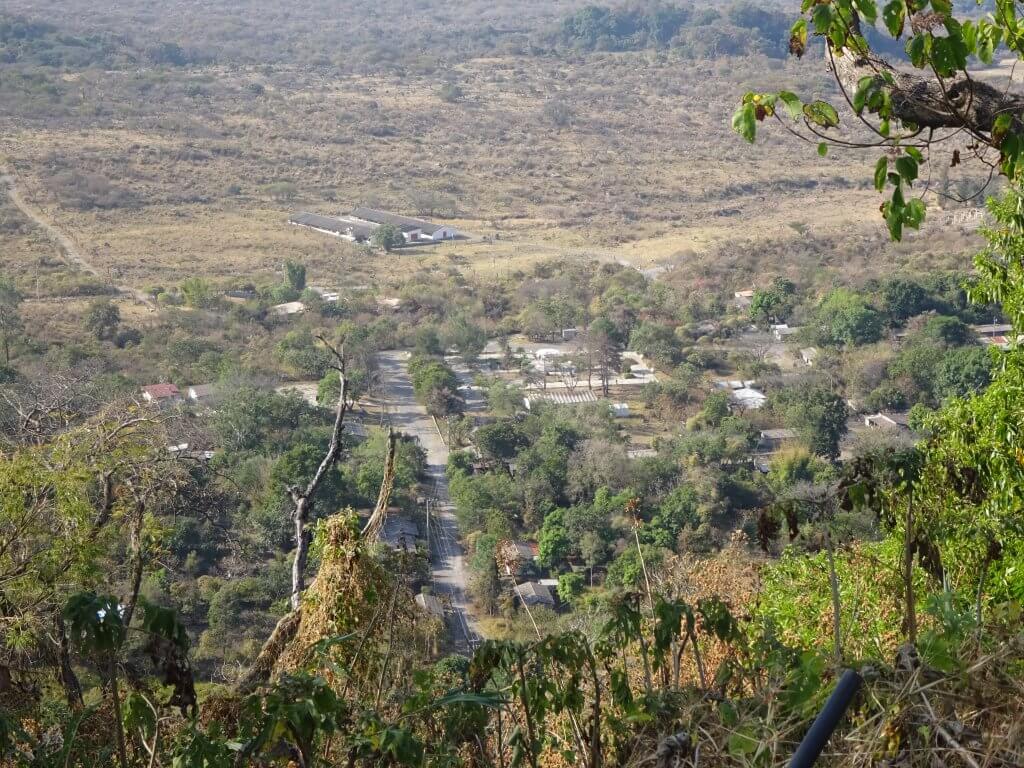
Hacienda de San Antonio
Getting As Close As You Can
The next stop was for the viewpoint of the volcano. It was a short walk from the bus through lime tree orchards to the closest point you can get to the volcan. This is 7km away from the peak, even volcanologists don’t go any closer! Unfortunately, there was no activity from the crater, but it was still an impressive sight.
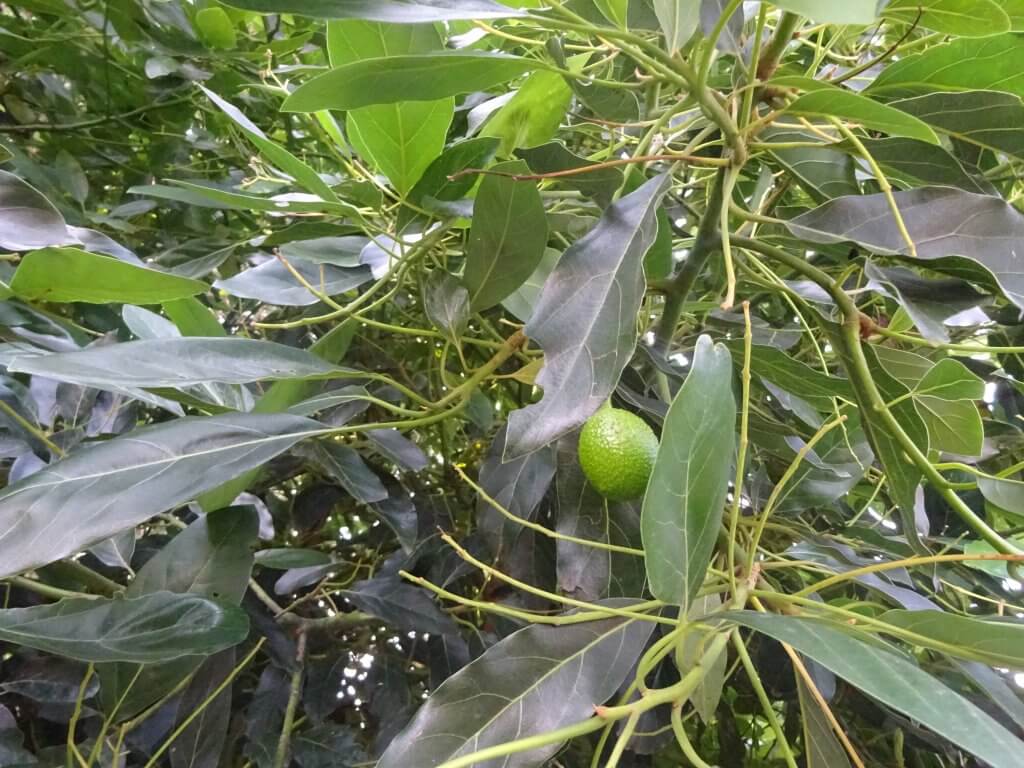
There was also an awesome tree in the field. I have no idea if there is anything significant about the tree, but it looked awesome, with vines hanging down. It was practically split in two and you could walk through it. Pretty cool!
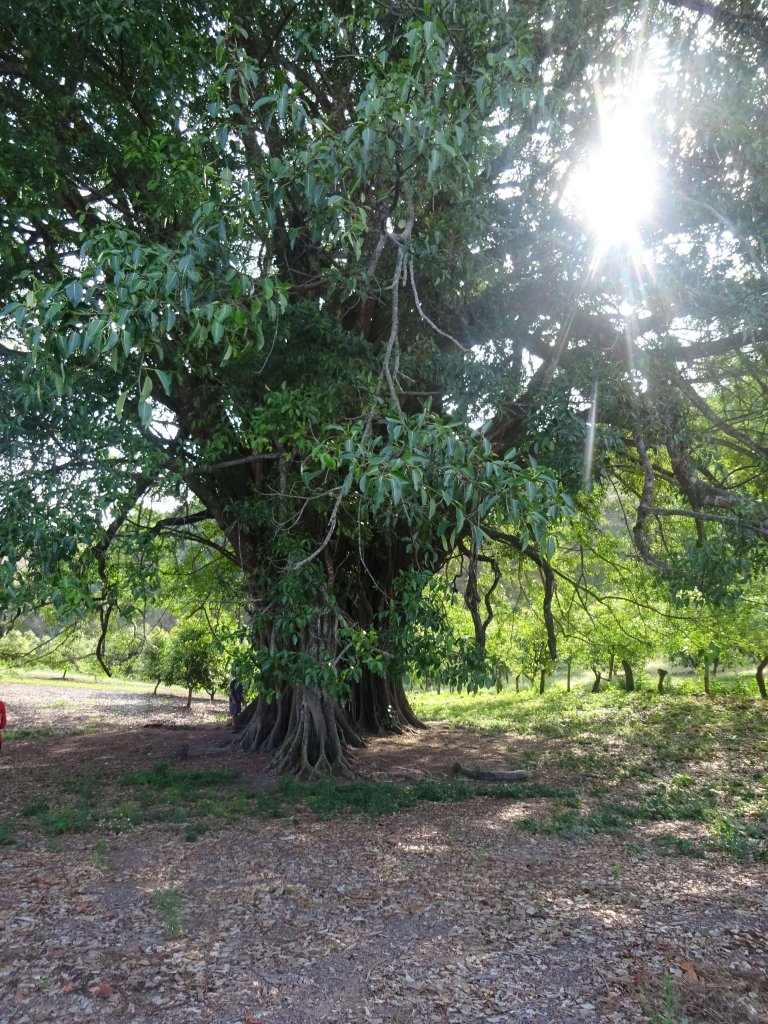
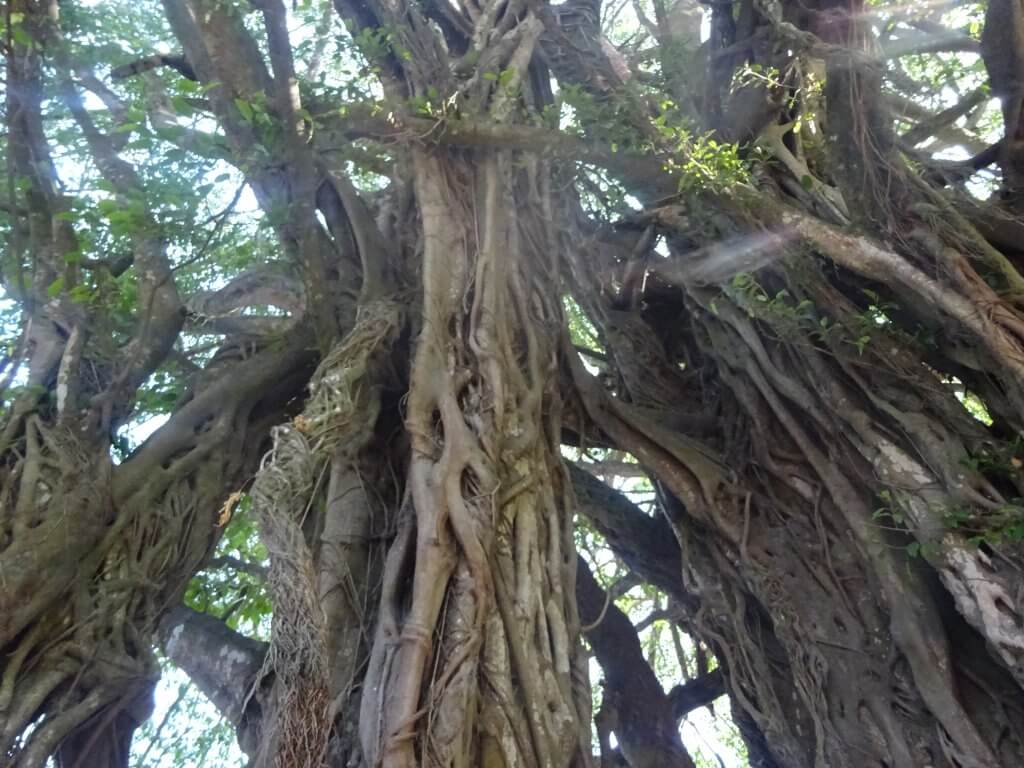
Vine Like Structures
As we admired the volcano, Jupiter told us about the recent eruptions. In May 2005, the volcano erupted. It was the largest eruption for several years, after this eruption the authorities set up the exclusion zone around the peak. Eruptions also occured in 2014, 2015 and 2016. The most recent eruption however was in January 2017, so I was visiting just over a year later. From the years of the eruptions you can see how active Fuego is.
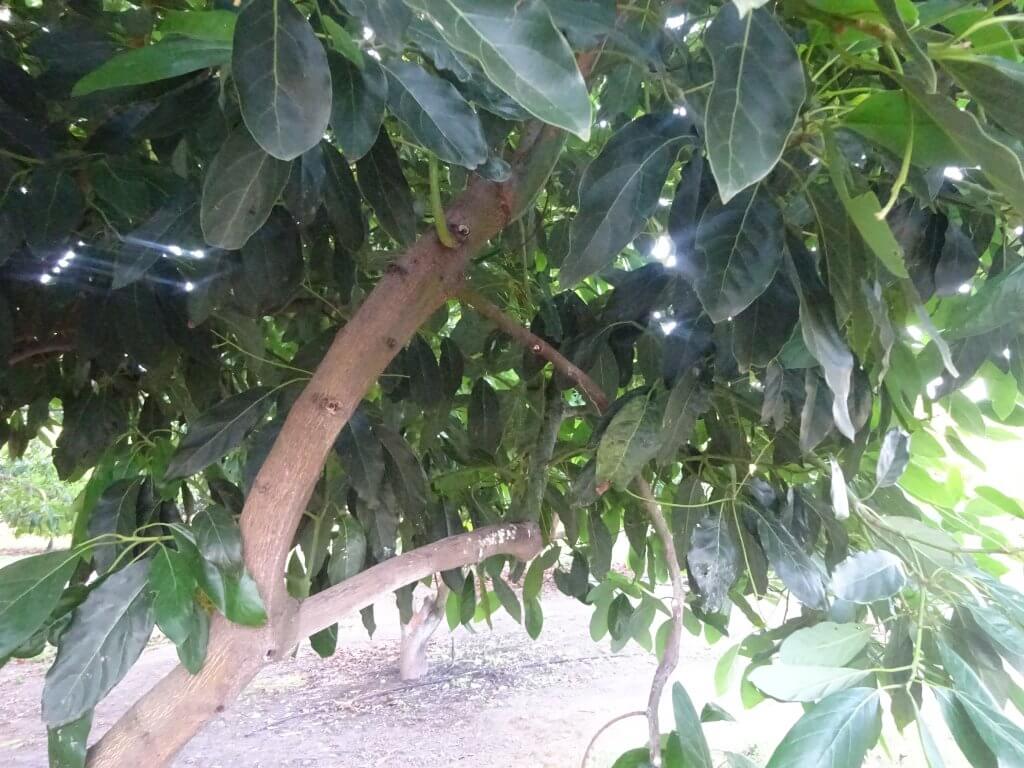
These eruptions have had impacts on local life, obviously. Jupiter showed us that on the lime trees you could see the see evidence of the eruptions. Where the trees were covered in ash the year before, the growth stopped. The new growth surrounded these stunted branches. There was also a nearby village that was evacuated during one of the recent eruptions. Since then very few people have returned, just some older people. Jupiter told us that it is like a ghost town.
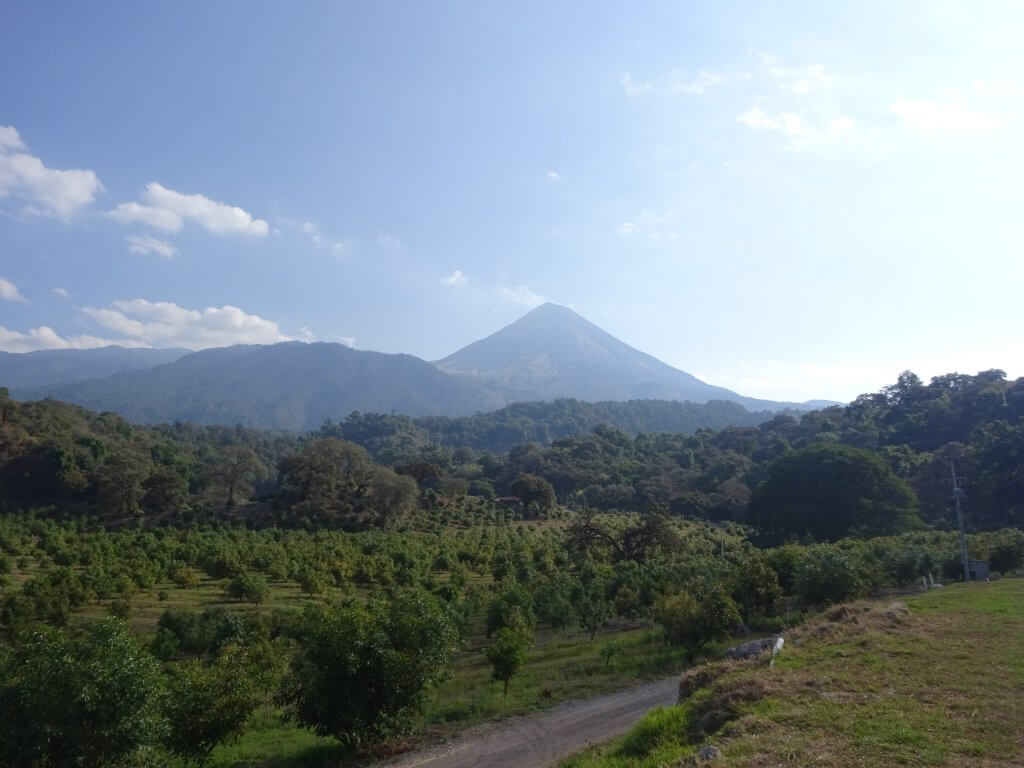
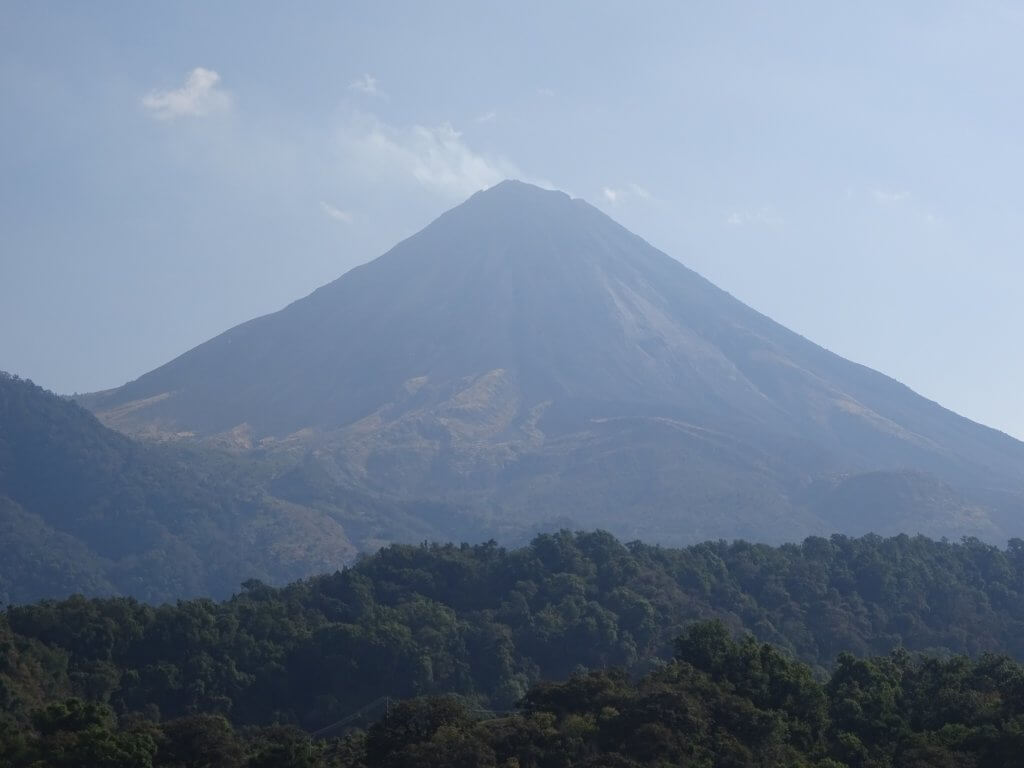
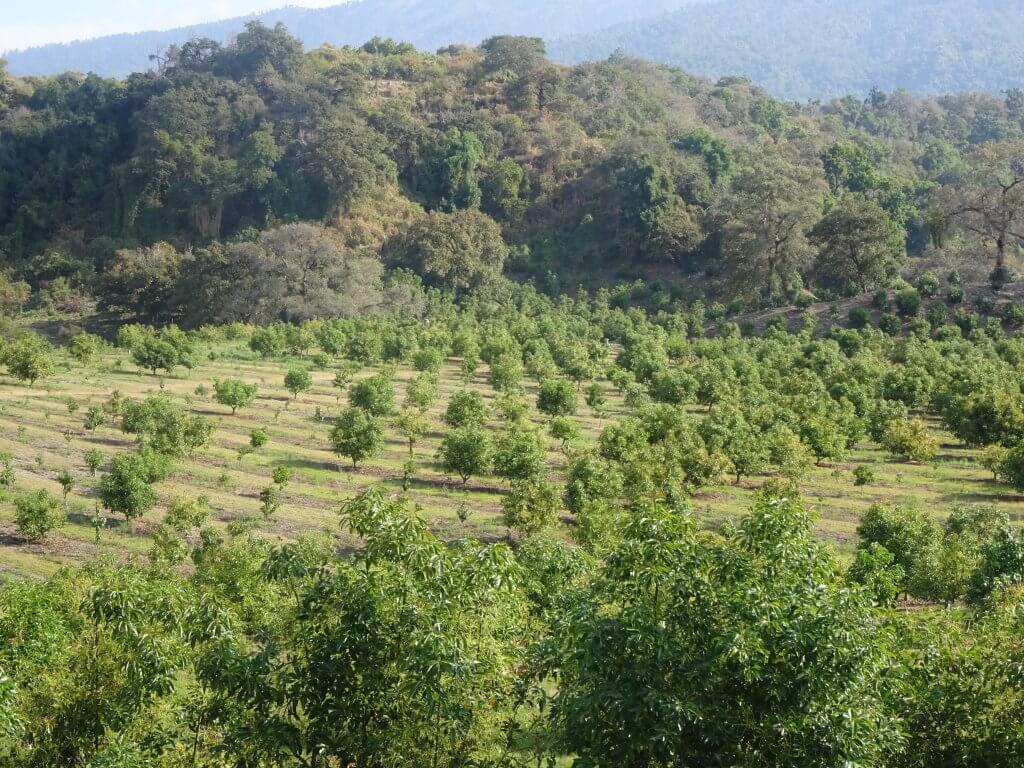
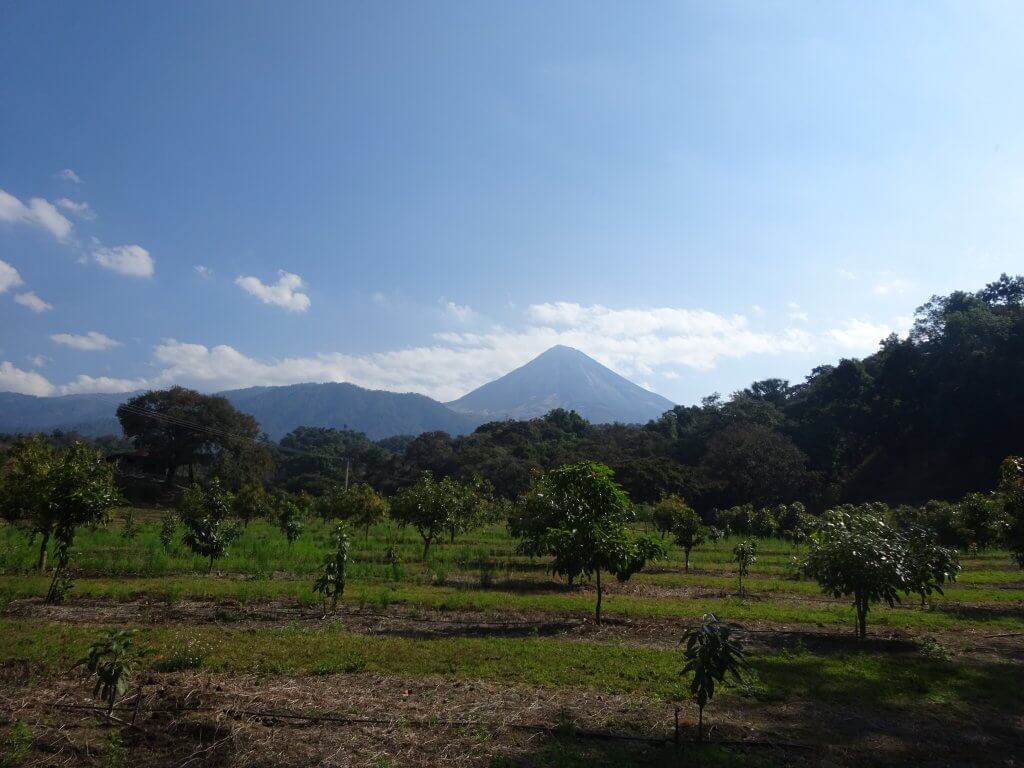
AVolcan de Colima
A Coffee Farm
On the way back we discovered that Jupiter was a keen birder; he pointed out a few and stopped and listened at any bird song. This was definitely his passion once he got talking about it!
As we drove away from the viewpoint, Volcán de Colima could be seen through the windows. It didn’t seem to be getting any smaller as we drove away… As we drove Jupiter told us that Volcán de Colima is part of the Colima Volcanic Complex. This complex consists of three volcanoes, Volcán de Colima, Nevado Colima and El Cántaro (which is extinct). The eldest is El Cántaro and the youngest Volcán de Colima, they appear to be in a line when you look at them. It seems likely that one day (though maybe in centuries to come) another volcano may appear in this line.
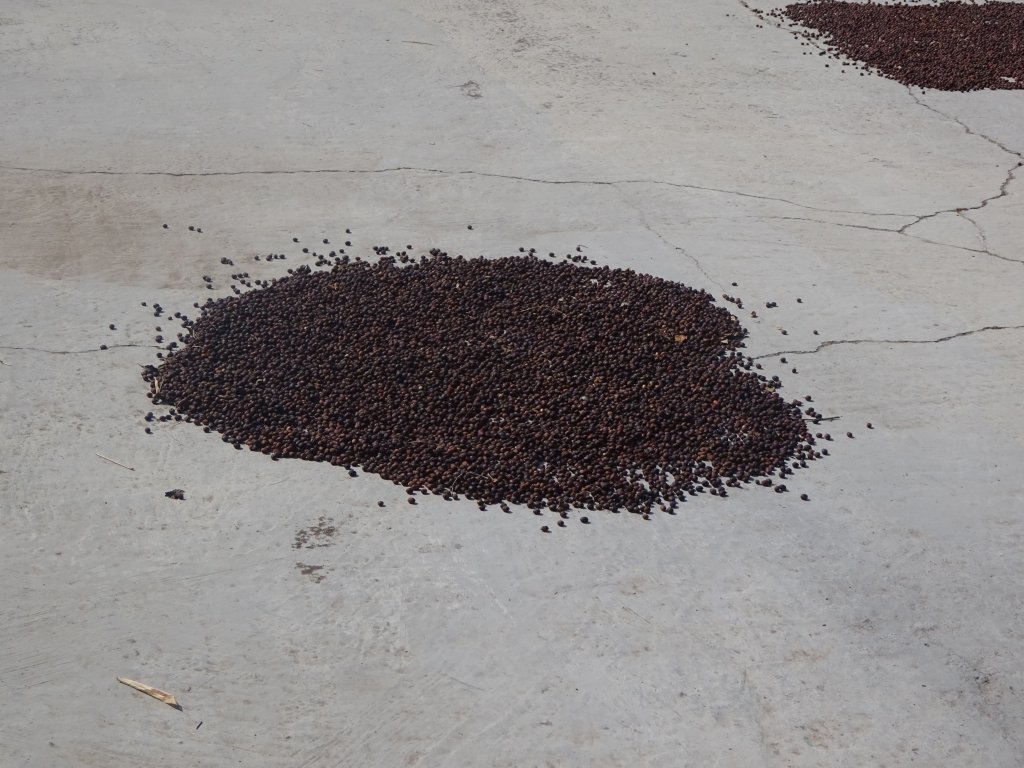
Our next stop was Yerbabuena, a coffee farm. As we headed to the cafe area I noticed coffee beans on the ground, some were almost in the shape of a heart. There were several collections of beans, all were laid out in just one layer. We wondered why they were laid out on the ground.
Once in the cafe, we all had some fresh coffee and some bread. The coffee was very good!
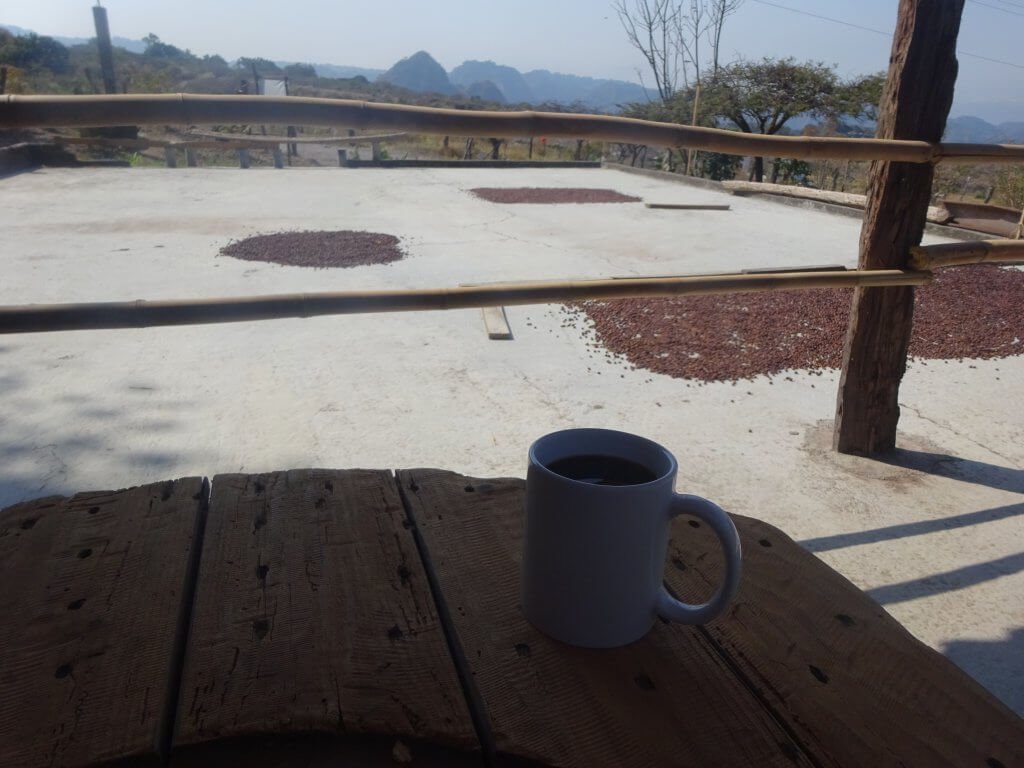
Enjoying A Cup Of Coffee
A Presentation Or Two
As we drank the amazing coffee and munched on bread, Jupiter told us more about the volcano. He even had a little presentation with pictures and videos! So well prepared, I loved it! This wasn’t just about the Volcán de Colima though, this was a lesson on volcanoes themselves.
So, incase you are interested (I found it very interesting, but I like stuff like this…)
Types Of Volcano
There are three types of volcano: Strato; Shield and Dome.
A Strato is a steep sided cone formed by layers of ash and lava flow. They tend to have explosive and dangerous eruptions – this is what Volcán de Colima is.
A Shield volcano is generally low with gently sloping sides formed by layers of lava. These don’t have explosive eruptions, but can produce fast flowing lava that can flow for many miles. An example of this type is Mauna Loa in Hawaii.
Dome volcanoes are roughly a circular mound, with steep sides. These produce acid lava which much thicker than lava so it does not flow very far before it cools and hardens. Mount Merapi in Indonesia is an example of this type.
Types Of Eruptions
Eruptions can be either effusive, where lava flows like a sticky liquid, or explosive, where fragmented lava explodes from a vent. There are also three metatypes, within two of these there are also subtypes. Sounds complicated, right? Well here’s a bit more detail:
Magmatic Eruptions
These eruptions are caused by the compression of gas in the magma, which then propels it forward. There are five subtypes:
Hawaiian eruptions are the least dangerous type. Fluid basalt leaves the volcano with very little gas content. Eruptions can occur at vents around the summit, as well the main cone. The flows move slowly down the cone. Mount Etna, Italy, shows this kind of eruption.
A Strombolian eruption ejects volcanic bombs and lapilli fragments that land around the source vent. This steady accumulation of fragments builds cinder cones composed of basaltic pyroclasts. These eruptions are caused by gas bubbles in the magma bursting. The eruptions are normally short lived and explosive. A volcano that erupts this way is Parícutin, Mexico.
Colima shows Vulcanian eruptions. Similar to Strombolian eruptions, they are caused by gas pressure building up, causing the cap that is holding the magma down to pop. These explosive eruptions wear down the lava dome. Volcanic bombs and blocks are deposited near the vent, but the main deposit is ash.
During Peléan eruptions large amounts of ash, lava fragments, gas and dust explode out of the central crater. Often before exploding a bulge appears on the summit. The material collapses in on itself and creates a fast moving pyroclastic flow that can travel at speeds over 90 miles per hour. Mayon Volcano has this type eruption.
Dissolved volatile gases building up in the magma conduit causes Plinian eruptions. Once these bubbles reach a certain size they explode. Because the conduit is narrow, the gases and magma are forced up in a eruptive column. The pyroclastic flow can travel over 430 miles per hour, which causes the most danger. The most well known volcano that erupts this way is Mount Vesuvius, which buried Pompeii and Herculaneum.
Phreatomagmatic Eruptions
These eruptions occur when there are interactions between water and magma. The difference in temperature causes violent interactions that lead to eruptions. The three subtypes are:
Shallow water interactions between water and lava cause Surtseyan eruptions. This is an explosive eruption, caused by the lava heating the water. This causes steam which expands violently, fragmenting the lava that it is in contact with into fine grained ash. They are the ‘wet’ equivalent of Strombolian eruptions. Surtsey in Iceland has this eruption type.
Underwater, Submarine eruptions occur. These remained virtually unknown until the 1990’s when advances meant that they could be observed. These can be driven by various processes. They can also produce seamounts that break the surface of the water, forming volcanic islands and island chains. The Bowie Seamount in Canada are examples of this eruption.
Subglacial eruptions are caused when lava interacts with ice, often this occurs under a glacier. Not much is known about these eruptions, as the study of this type is relatively new. An example of this type of eruption is Brown Bluff in Antarctica.
Phreatic Eruptions
There are no subtypes to this type of eruption. Phreatic eruptions are caused by the expansion of steam. When cold ground or surface water comes into contact with magma it superheats and explodes. This fractures the surrounding rock and throws out a mixture of volcanic bombs, volcanic blocks, steam, ash and water. Taal Volcano in the Philippines shows this type of eruption.
A Bit About Coffee
After all this information, Jupiter showed us some videos of Colima. These were videos of the volcano smoking and erupting. They were pretty impressive to see.
We then got to learn a bit about the coffee. Jupiter told us that they roast the coffee here by hand and showed us some equipment like the grinder. In the area two techniques are usually used for roasting: Colombian and Brazilian. It also turns out that the coffee beans were in the process of drying. Well, when you have such warm weather you might as well use it, right?
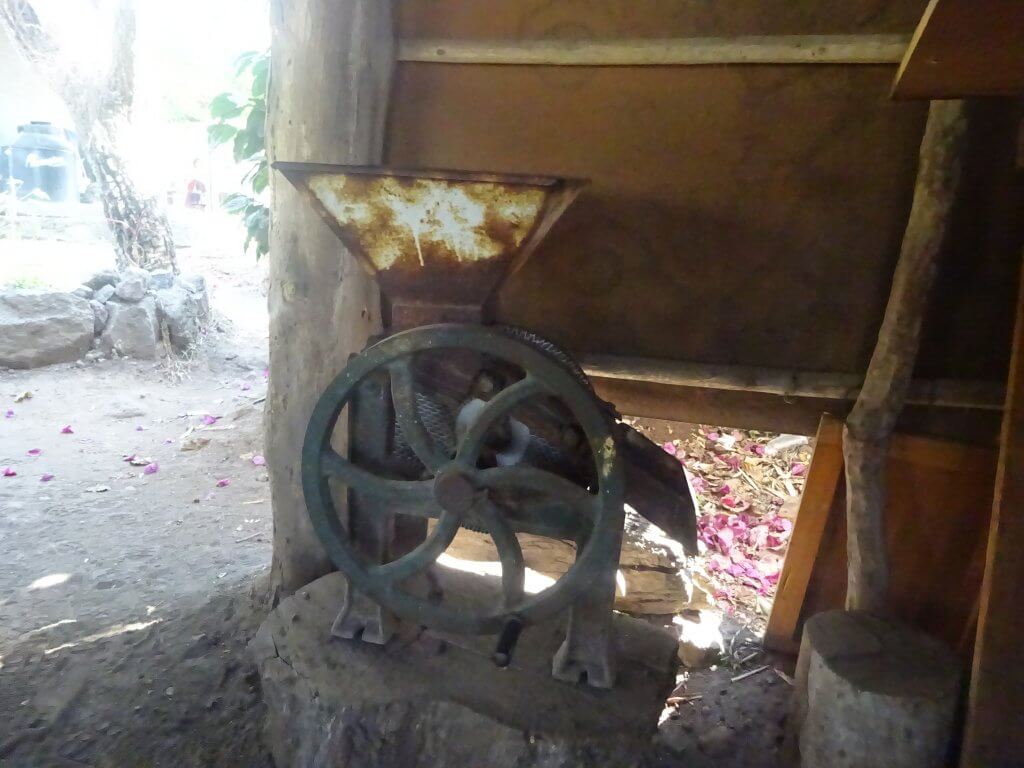
A little while later we had all finished our coffee and so headed to our next destination. It wasn’t long before we arrived. We were at a lake, or so I thought. Jupiter told us that this was a Caldera, this is a cauldron-like hollow that is formed after the evacuation of a magma chamber. The Caldera we were visiting had since been filled with rainwater.
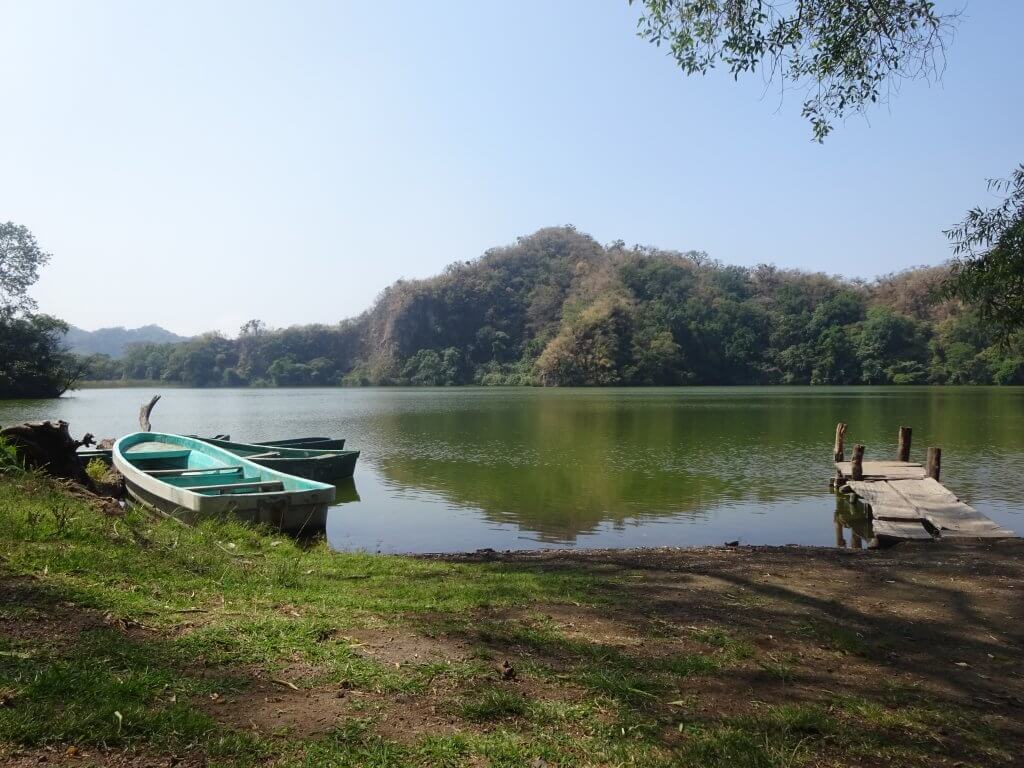
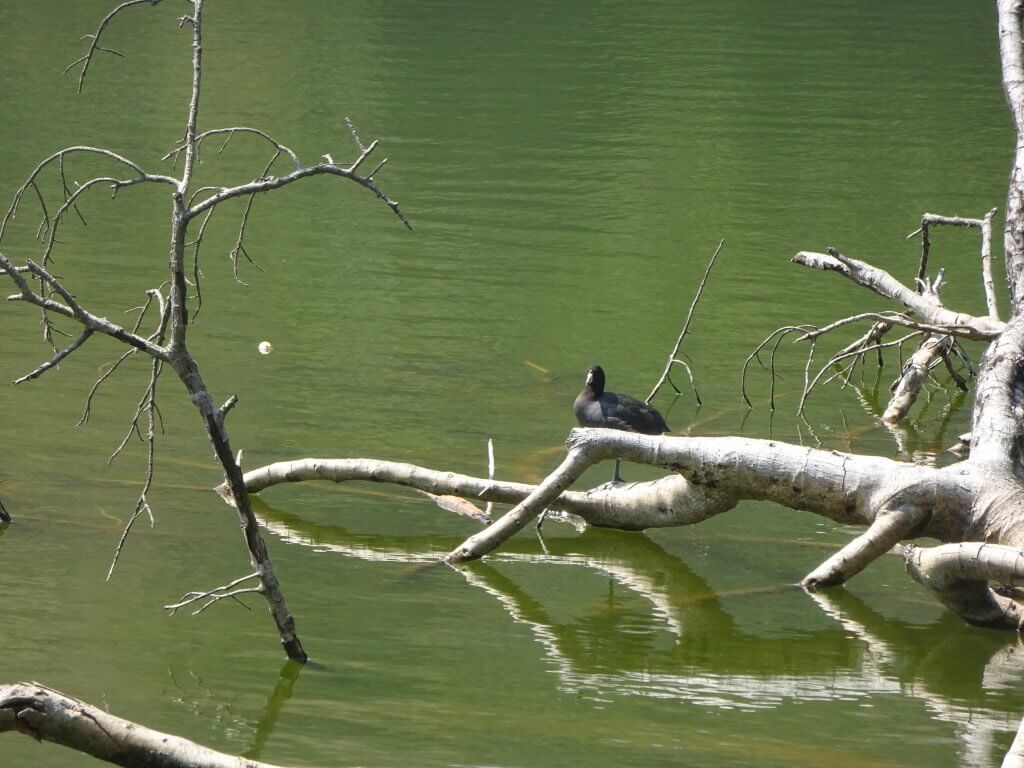
Coot On The Caldera
Coffee Trees
We had a short walk on the edge of the Caldera, which was surrounded by forested slopes. The water looked green, but was still picturesque. As we walked Jupiter happily pointed out birds that he noticed.
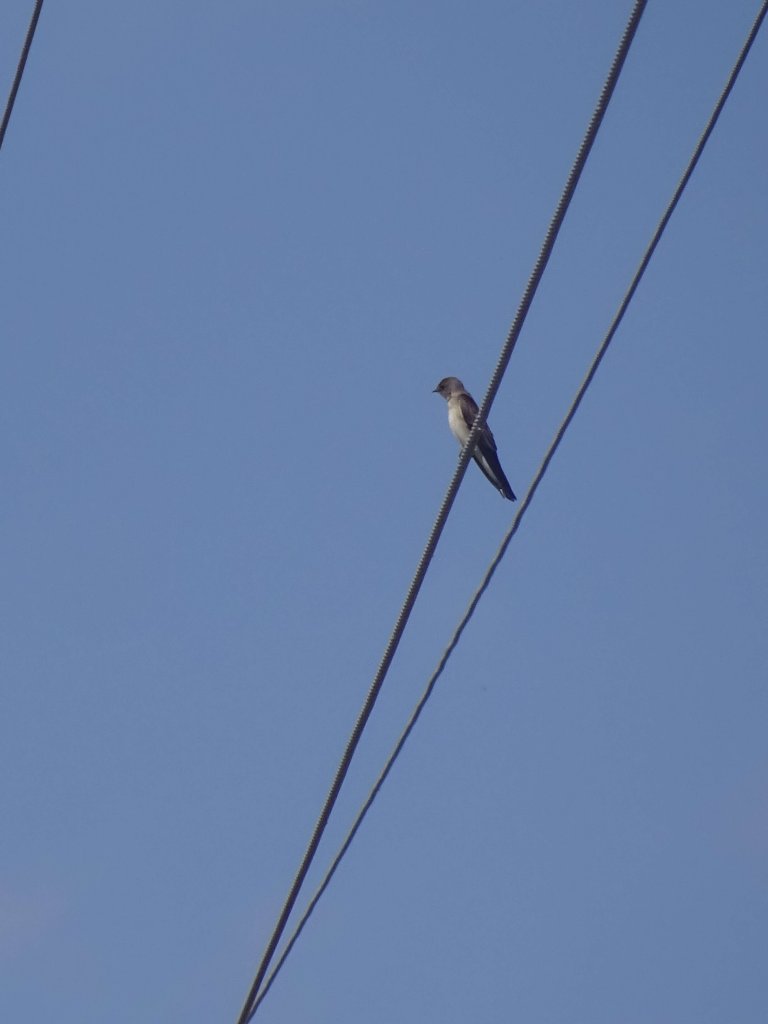
We went into the slopes surrounding the Caldera. Underneath the trees were coffee trees. Did you know, coffee requires five things for optimum growth: temperature between 20 and 27 degrees C; shade; soil with high nutrients and good drainage (like volcanic soil); altitude between 600 and 1,800 metres; abundant rainfall.
The coffee trees were in fruit too, so he pulled a couple of cherries off and allowed us to taste. There’s not much flesh on the cherry and for me it didn’t really have much taste. In the can be found the stone, or coffee beans. At this point the beans are smooth, round and light green in colour. Not what I expected at all!
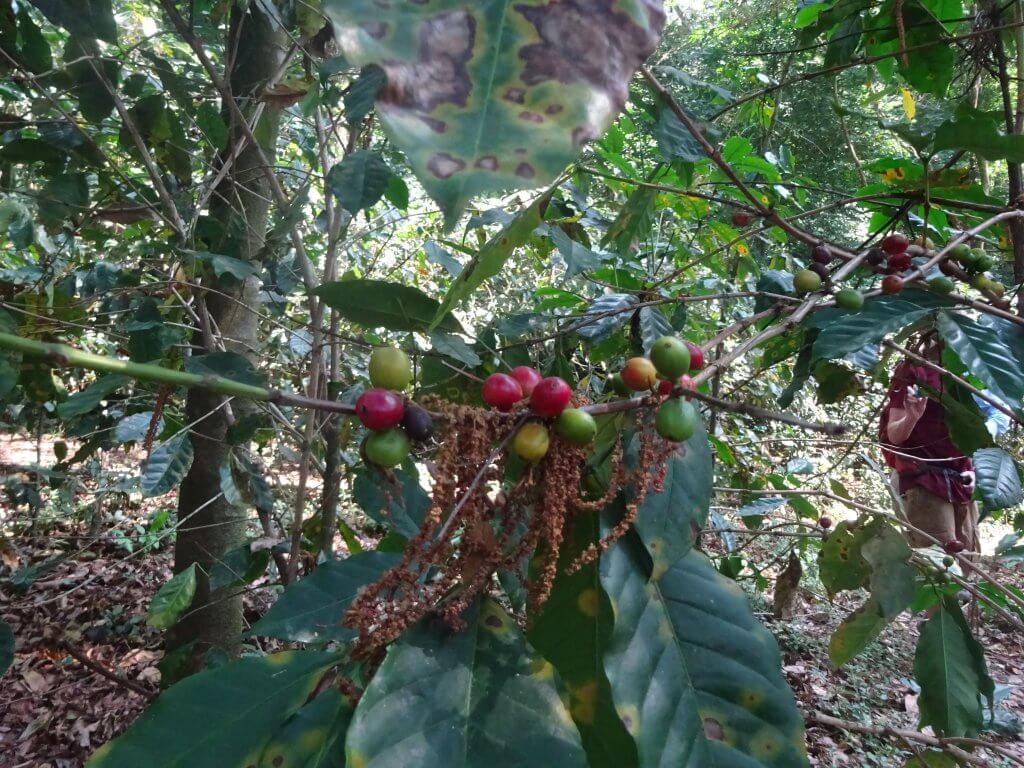
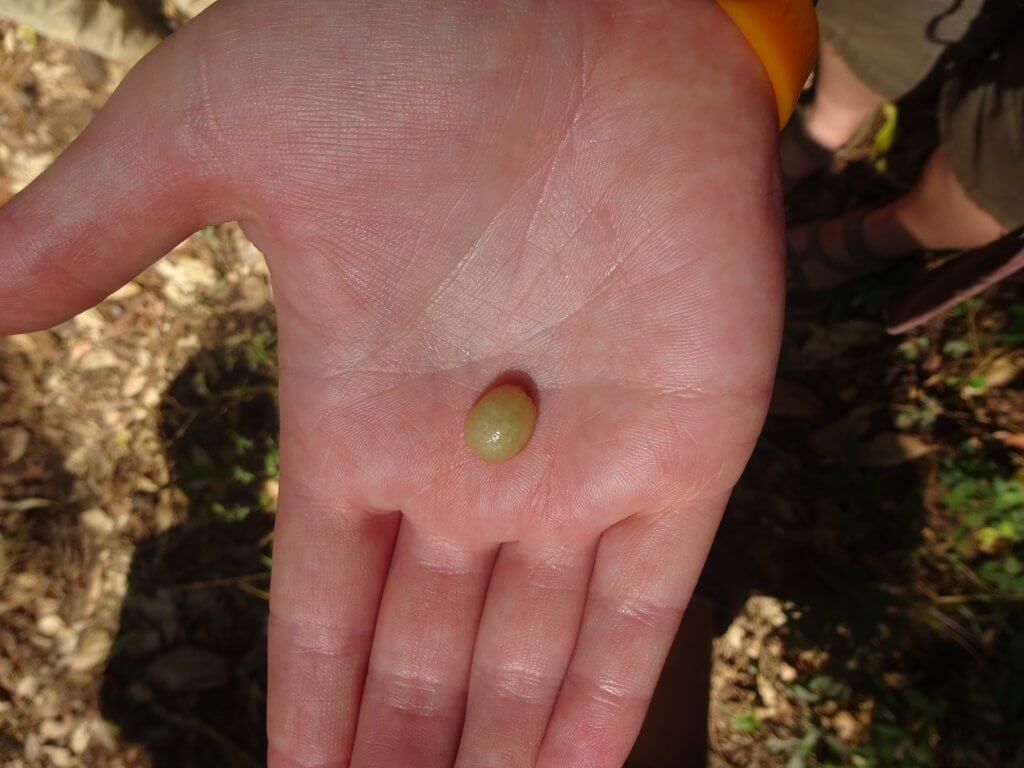
Raw Coffee Bean
The Magic Zone
On the drive to our next stop something magical happened. We were heading up a hill, which had two lanes. Jupiter moved over into what I’d call the slow lane. Here he stopped. He showed us that he had put the minibus into neutral. Next he took his foot off the brake…
We rolled forward! Uphill! Seriously. We rolled uphill. Not down, up. This is known as Zona Magica (Magic Zone), there are a few of these places around the world. It could be an optical illusion, or to do with the earth’s magnetic field. Whatever the reason it is definitely weird to experience!
The Mask Maker
Our next stop was a small indigenous village. Here we went into a house of a mask maker. He is the only mask maker of this type left. There were masks over the walls of different things, animals, human faces and more. Some were coloured, some were not. My personal favourite was a humanesque face with a lizard and a snake.
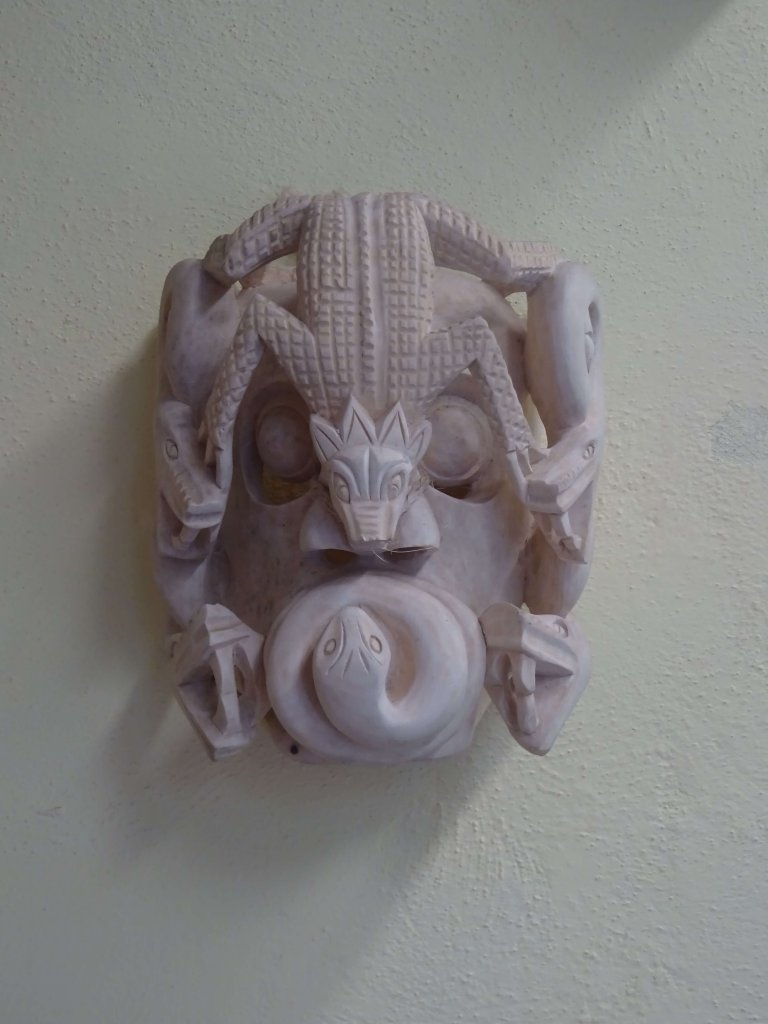
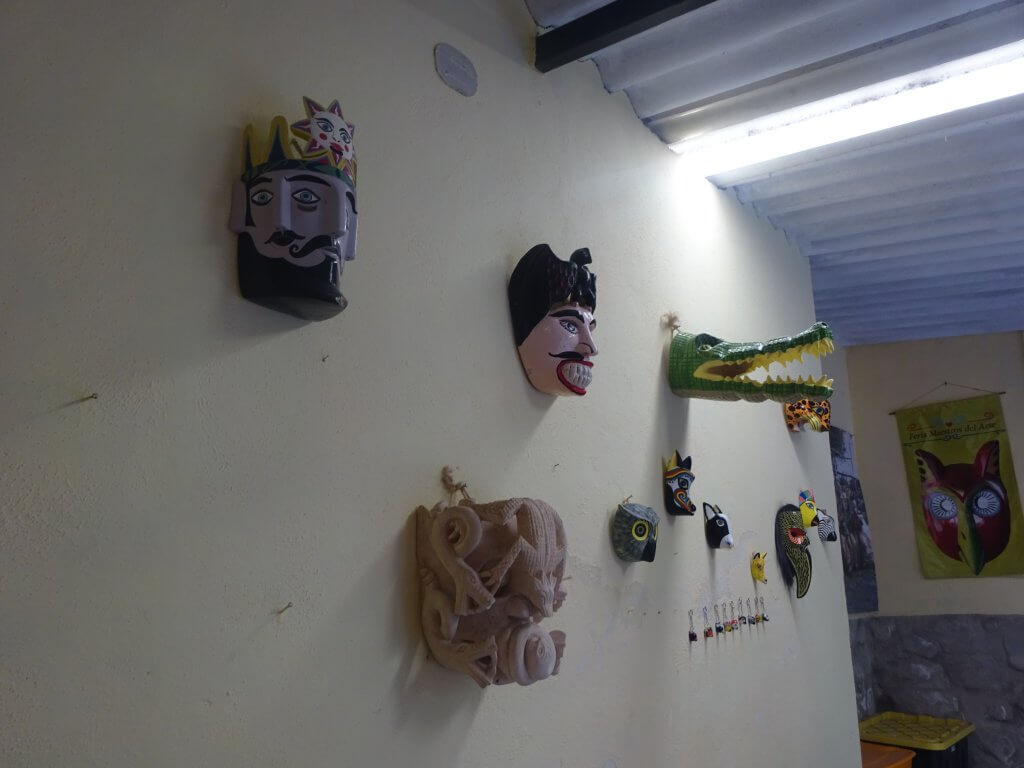
Wall Of Masks
The mask maker got on with his work and Jupiter showed us a few things. He showed us some of the tools used to make the masks. The mask maker only uses two types of wood, the two types were passed around. One was definitely heavier than the other. As the mask maker worked, we could see that he was doing everything by hand. Slowly, painstakingly. The attention to detail is amazing. Because of this it takes him weeks to create even the simplest mask.
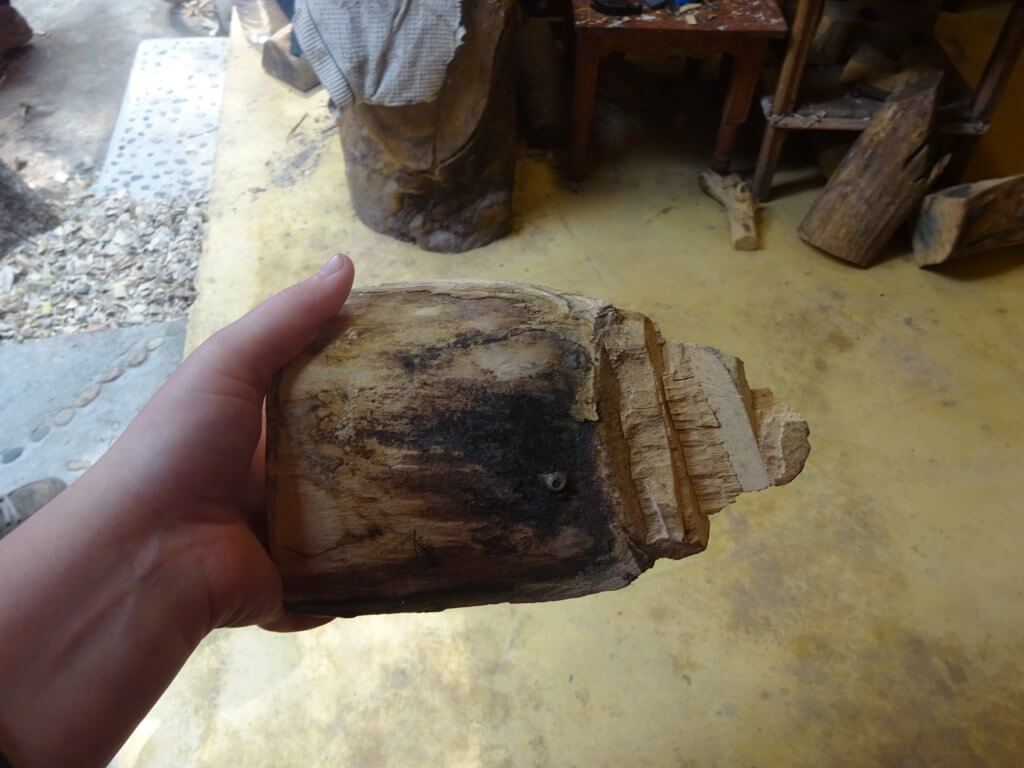
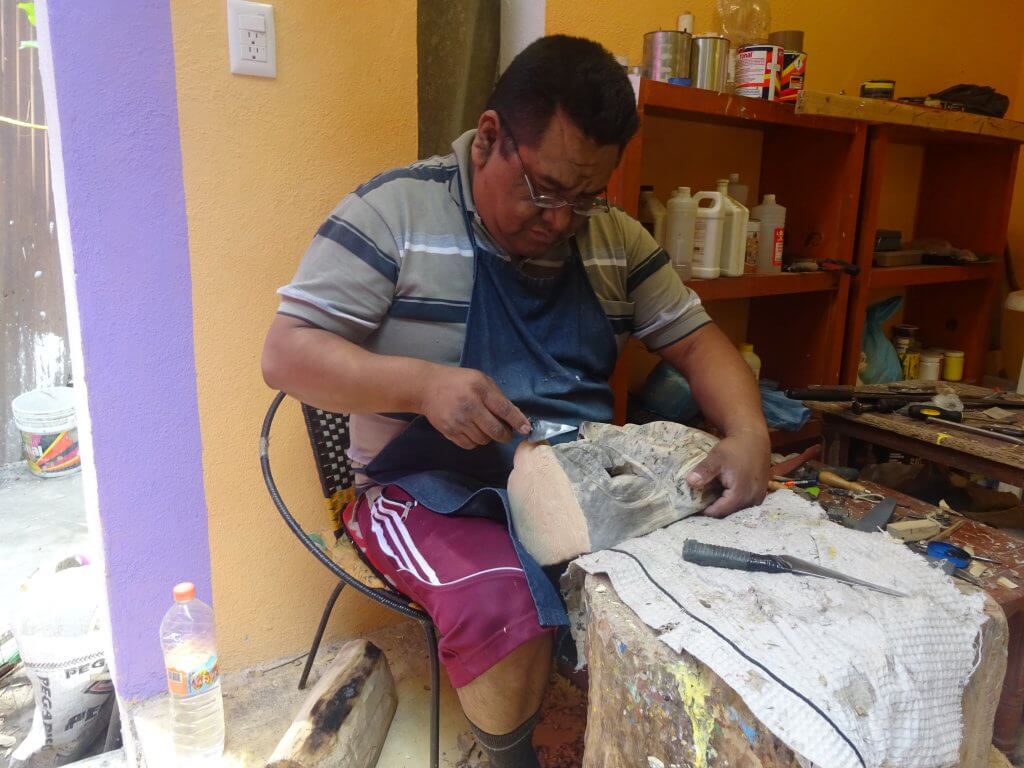
Mask Maker At Work

As we were meant to leave, we all got a little distracted – there were a couple of owls in a tree. Luckily, as Jupiter is a birder, he made sure we all spotted them before we left and didn’t mind the distraction. They were pretty hard to spot, but with a bit of direction we all manage to spot them.
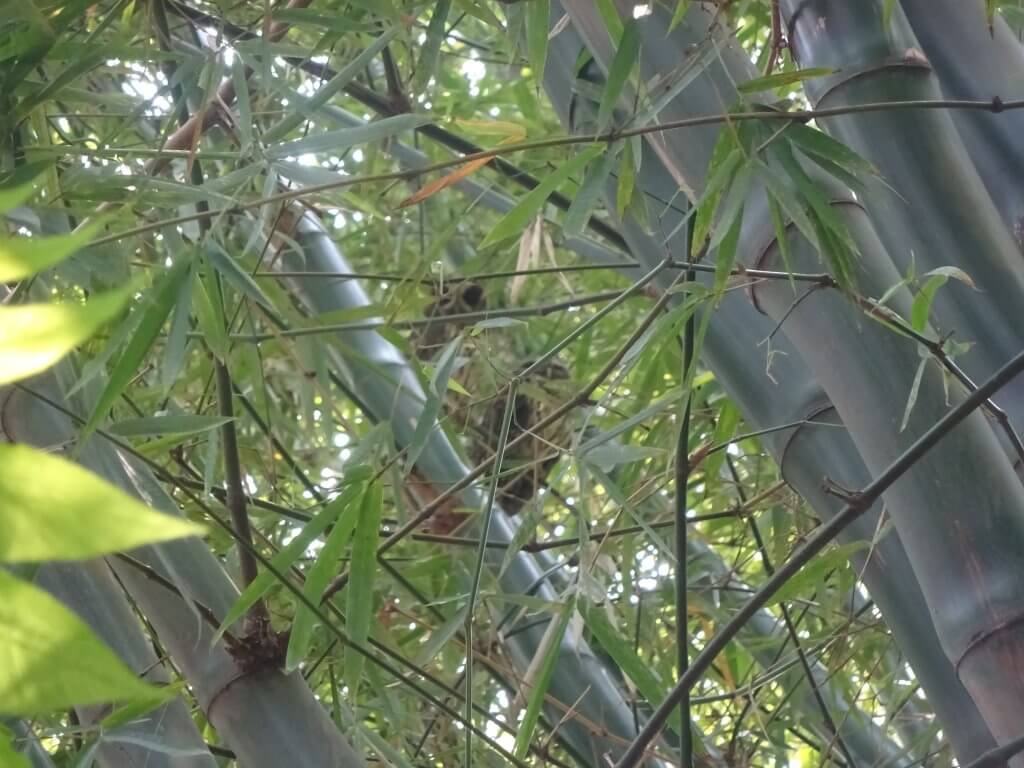
Owls In The Tree
An Artists’ Museum
Just a short drive on was our final stop of the day, Museo Universitario Alejandro Rangel Hidalgo. In this old house is his artwork and collection of pre hispanic pottery. As we entered Jupiter told us an interesting fact about cobbles that I didn’t know. There were cobbles in the entranceway of the building, the cobbles help to remove dirt from horses hooves as they enter – this also works for boots. I never realised cobbles had a reason before!
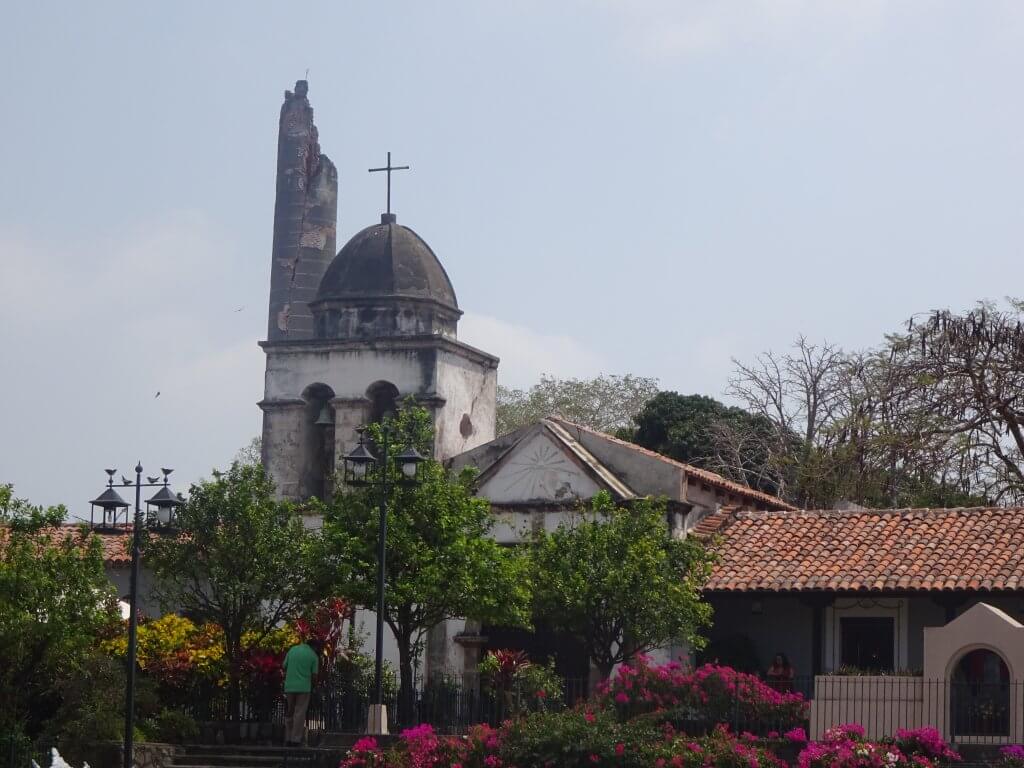
The first room we went into was a replica of an old Mexican kitchen. I found this quite interesting. There was a large wooden shelf (a zarzo) that could be raised and lowered for storing meat, this meant that animals couldn’t get to the foodstuffs, genius. There was also an old water filter device. Not sure how effective it would be. Amongst the large collection of pottery, I spotted a metate, similar to the one I used during my cooking class in Oaxaca.
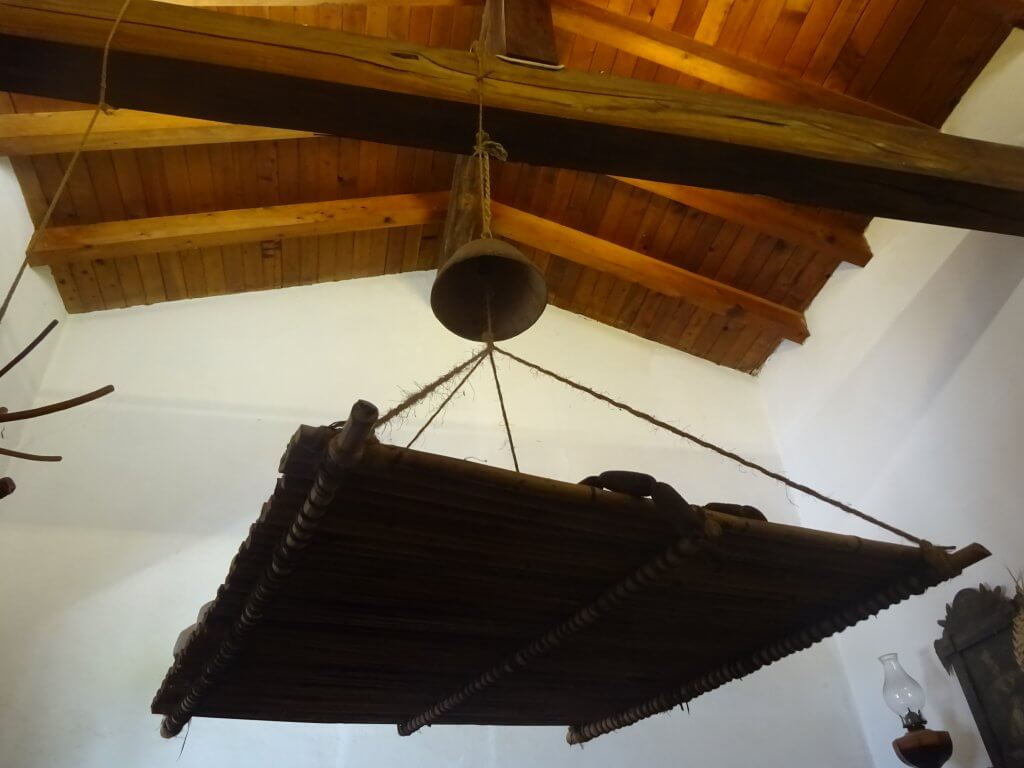
We then moved on to see the artwork and the collection of pottery. Unfortunately no pictures were allowed in these rooms, so you will just have to imagine (or go yourself).
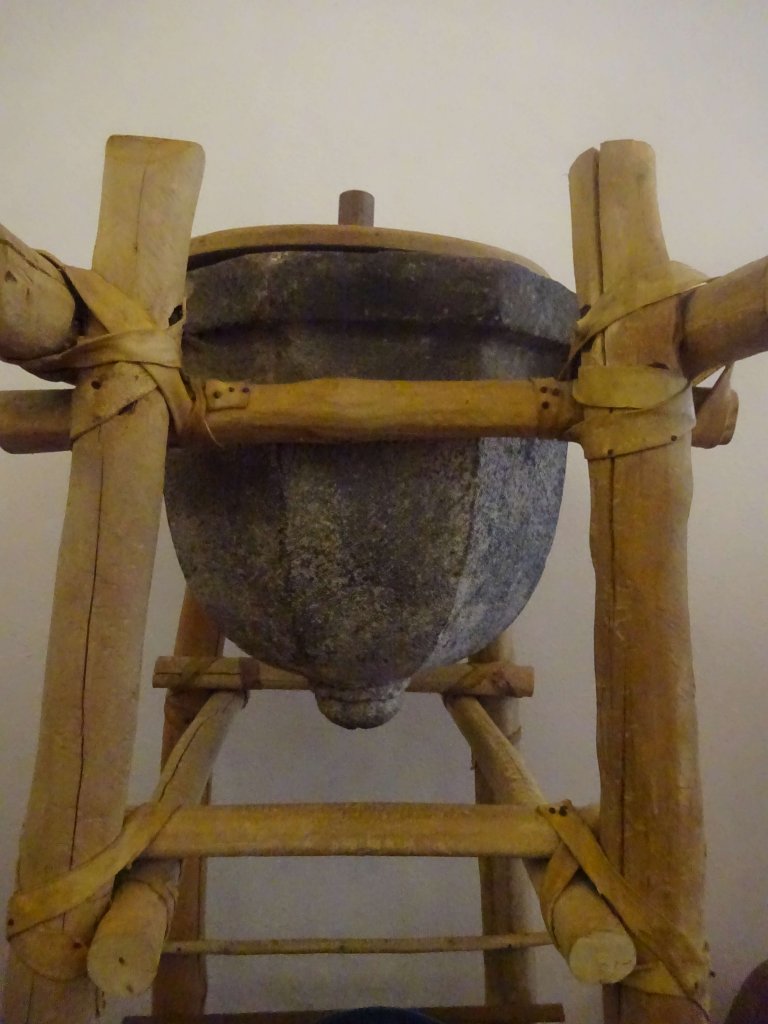
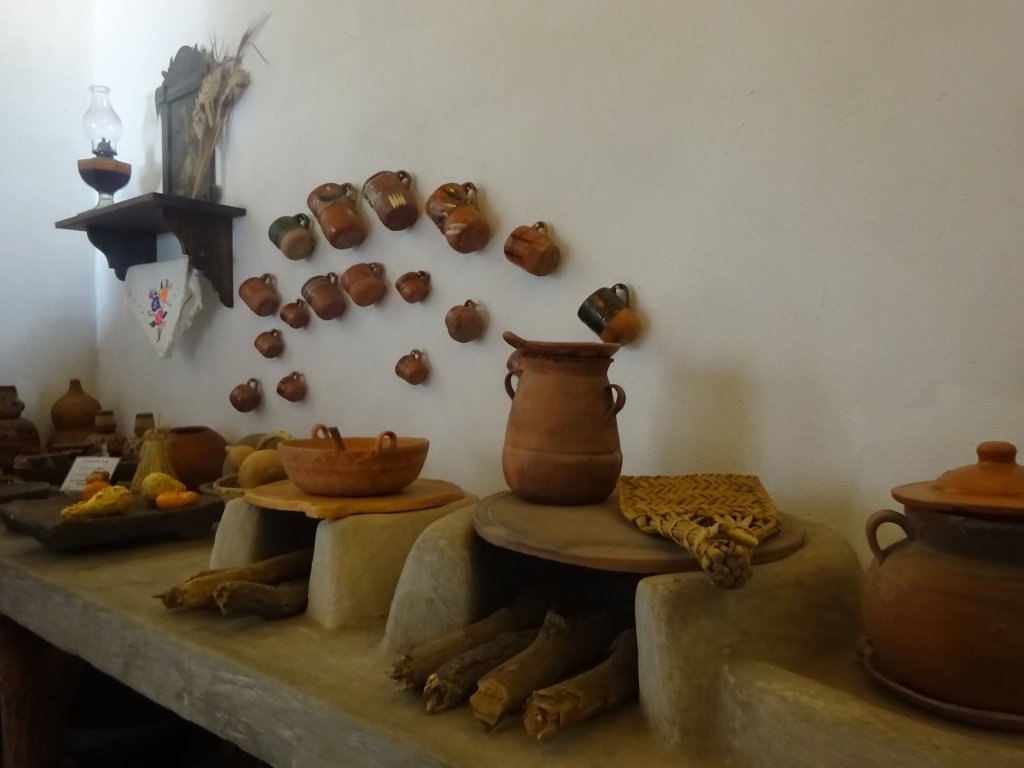
Cooking Pots
Artwork And Pottery
The artwork was pretty interesting. Hidalgo managed to make to 2D images look 3D. It was really weird when you looked up close. There were some bizarre paintings of children with objects, they had pointed fingertips and flattened heads, this was a distinct feature of Hidalgo’s work.
My favourite works though were “Angels of the World” these pieces howed angels in different culture’s dress. I find things like this fascinating. I feel it shows how all the cultures are different and yet the same.
The pottery was in a darkened room, which was under very close control. There was an impressive amount of pottery, but the main thing I remember was the dog figures. There were two distinct sorts, one fat and one thin. The fat dog is likely a representation of a type of dog used for food, the thin one probably more of a pet.
Dogs were very important to the natives. Often dogs would be sacrificed when their owner died, so that they could help the owner to get to the underworld.
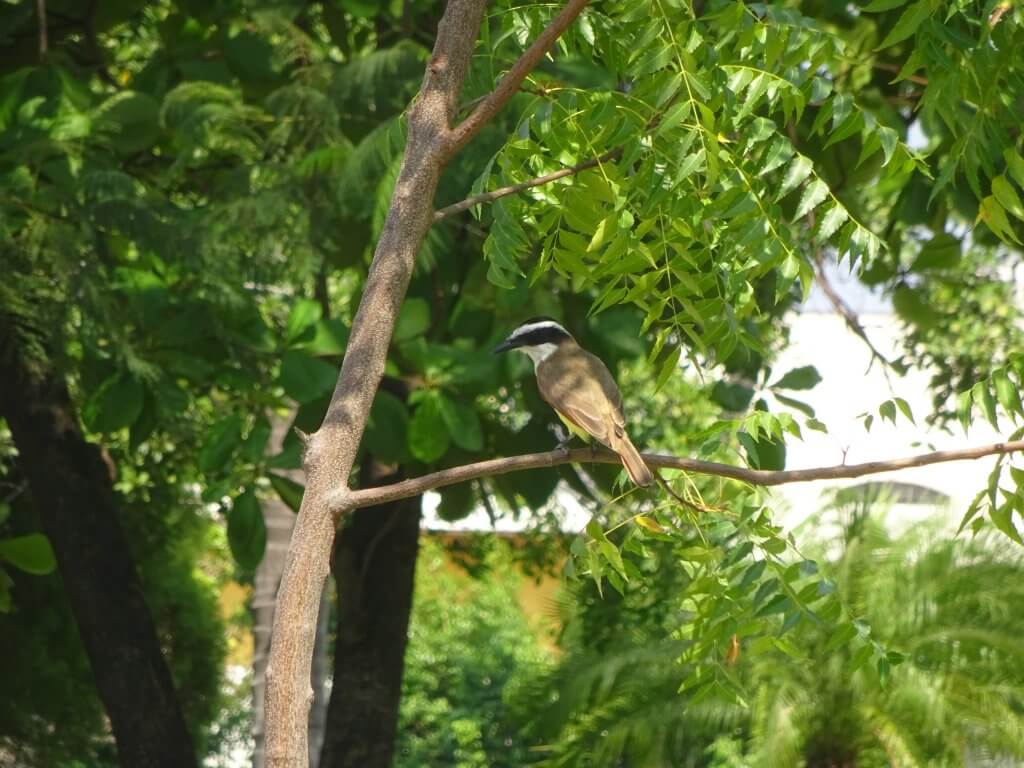
A Little More Art
As we wandered around I noticed a painting of a piñata. I learnt something very interesting here! Apparently, the original piñata was always in the shape of a seven pointed star. This represents the seven deadly sins. So the piñata is temptation, the person who is blindfolded and given a stick represent faith. The process of hitting the piñata with a stick represents the struggle of man from temptation. Once the piñata is destroyed the treats inside are a reward for keeping faith. This used to be done only during Lent.
Hidalgo also made furniture, as well as painting. He used local hardwood such as mahogany and made some beautiful pieces. Though the main one I remember had small draws. On the draws were images of plants and it told you their medical properties. It was like a old style first aid box!

Volcan de Fuego
Now it was time to head back to Colima. So we all got back in the minibus and Jupiter kindly provided us all with water from a coolbox – always much appreciated!
The journey back was uneventful and soon we were dropped off where we’d been picked up. So we said our goodbyes and headed back to our hotel.

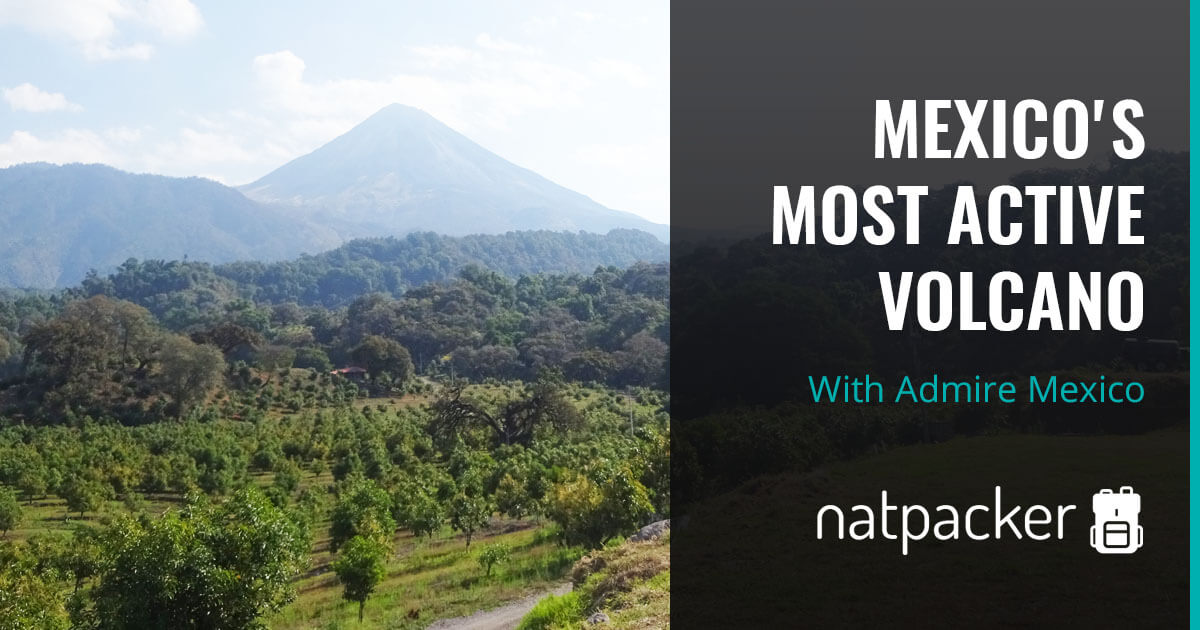
24 Comments
Oh my gosh, the Zona Magica sounds out of this world! Thanks for sharing such an in depth post about this volcano.
Zona Magica was definitely a bit trippy 🙂
What an amazing adventure!
It definitely was! Glad you enjoyed reading.
Thanks for such a comprehensive article of the area. I especially enjoyed reading about the different art. Those masks are absolutely amazing! I always think it’s really sad when there’s only one remaining person who knows a particular skill because when they’re gone that’s potentially it! I hope he is able to teach someone else since they’re so cool and presumably important to the village. Also quite ironic that dogs are so important they kill them so they won’t be separated!
Glad you enjoyed the read 🙂
I know what you mean about the art, hopefully the mask maker will teach someone else so the art won’t be lost. The masks are so intricate and beautiful.
Wow a lot of stories and information here. Sounds like quite an adventure!
It definitely was an adventure.
Wow, what a beautiful place! Such a great detailed guide.
Glad you enjoyed reading. It really is an incredible part of the world.
I have always been fascinated by volcanoes, and seeing floating lava has been on my bucket list for ages! I was lucky enough to climb the Nyiragongo volcano in Congo earlier this year, and it was the most amazing thing I have ever seen, sitting on top of the crater looking down on the boiling lava lake! Highly recommend it!
Loved the scenic lake/caldera, and rolling upwards the hill sounds like a surreal experience!
I did not know the fact about the pinata, or the cobbles for that sake. You really had a full day of impressions, and I learned a lot reading your post. Thanks for sharing!
Wow! I’ve never heard of Nyiragongo, but I’d love to climb it now. Volcanoes really are fascinating.
Glad you enjoyed reading. I learnt a lot on the trip and love to share what I’ve learnt.
I love learning more about Mexico! I had no idea that you could see evidence of the volcanic eruptions in the lime trees! It’s so interesting how in some ways, nature preserves its past.
It is really weird what you can see if you know what to look for. I had no idea either until Jupiter pointed the lime trees out.
Sounds like a great trip! It’s a shame you didn’t get to see any activity, and I didn’t realise there were 3 different types of erruptions.
It was great. I learnt so much about volcanoes. Such a shame he was quiet that day though.
wow this looks like an amazing journey. would love to visit one time. xo, Natalie
You definitely should visit, it’s an amazing place.
Good read on volcanoes! It’s like going back to science class. 🙂 I really want to experience the Magic Zone. Absolutely cool!
Lol! I do get a bit ‘into’ the science bits. Glad you enjoyed the read 🙂
A great source of volcanoes thank you so much for this information that even the science student can benefit from
Hi Riley,
I’m so glad you found it useful 🙂
Good read on volcanoes! It’s like going back to science class. Glad you enjoyed reading. It really is an incredible part of the world.
Thanks 🙂 Glad you found it useful